
i) Distinguish between back flash accounting system and just in time system
Just in time is an approach to operations planning an control base on the idea that goods services
should be produced only when they are needed and neither too early (so that inventories build up)
not too late (so that the customer has to wait). In words just in time is system
Back flash accounting system is a more simplified costing system for allocating costs between
inventories and cost of goods sold. The purpose of this is to eliminate detailed accounting
transactions. Rather than tracking the movement of materials through the production process a
back flash costing system focuses first on the output of the organization and then works
backward. When allocating cost between costs of goods sold and inventories with no separate
accounting for work in progress. Back flush costing is suitable for use in just in time environment.
Costs are attached to output only thereby simplifying the costing system.
ii) Features of Just in time
Pull Method of Materials Flow
Just-in-time systems utilize the pull method of materials flow. However, another popular method
is the push method
Consistently High Quality
Just-in-time systems seek to eliminate scrap and rework in order to achieve a uniform flow of
materials
Small Lot Sizes
Rather than building up a cushion of inventory, users of JIT systems maintain inventory with lot
sizes that are as small as possible
Uniform Workstation Loads
The JIT system works best if the daily load on individual workstations is relatively uniform.
Standardized Components and Work Methods
The standardization of components, called part commonality or modularity, increases repeatability
Close Supplier Ties
Because JIT systems operate with very low levels of inventory, close relationships with suppliers
are necessary
Flexible Work Force
Workers in flexible work forces can be trained to perform more than one job.
Line Flow Strategy
A line flow strategy can reduce the frequency of setups. If volumes of specific products are large
enough, groups of machines and workers can be organized into a product layout to eliminate
setups entirely
Automated Production
Automation plays a big role in JIT systems and is a key to low-cost production. Sakichi Toyoda,
the founder of Toyota, once said, "Whenever there is money, invest it into machinery.
Preventive Maintenance
Because JIT emphasizes finely tuned mows of materials and little buffer inventory between
workstations, unplanned machine downtime can be disruptive. Preventive maintenance can reduce
the frequency and duration of machine downtime.
marto answered the question on February 15, 2019 at 11:10
-
Stockmart Limited manufactures a product branded "Bora". The main raw material used in the
manufacture of 'Bora' is material 'MT2011'.
The current stock control policy of the...
(Solved)
Stockmart Limited manufactures a product branded 'Bora'. The main raw material used in the
manufacture of 'Bora' is material 'MT2011'.
The current stock control policy of the company is to order material 'MT20 II' twice a year. The
quantity of each order is equivalent to one-half of the year's forecast demand.
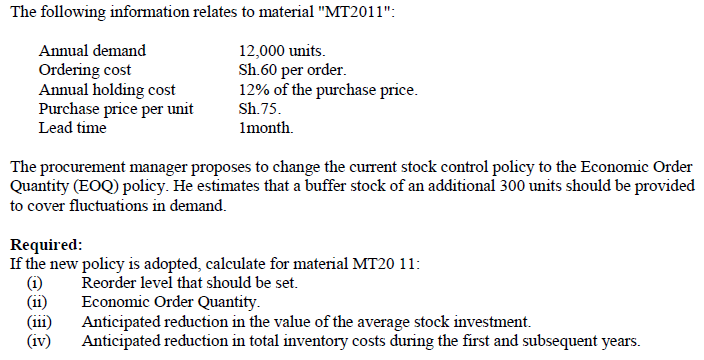
Date posted:
February 15, 2019
.
Answers (1)
-
BabyCom Limited manufactures different types of toys. The company engages three employees.
Abel, Bilha and Charles.
(Solved)
BabyCom Limited manufactures different types of toys. The company engages three employees.
Abel, Bilha and Charles.
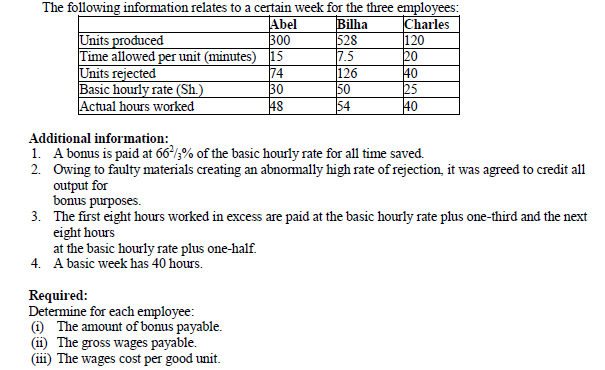
Date posted:
February 15, 2019
.
Answers (1)
-
Toy Master Ltd. is located at the industrial area in the capital city of your country. The company
makes quality toys to customer's orders. The company...
(Solved)
Toy Master Ltd. is located at the industrial area in the capital city of your country. The company makes quality toys to customer's orders. The company has three production departments; P, Q and R and two service departments; X and Y.
The overhead costs budget for the year ending 31 December 2012 is as follows:
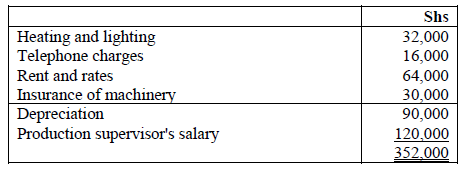
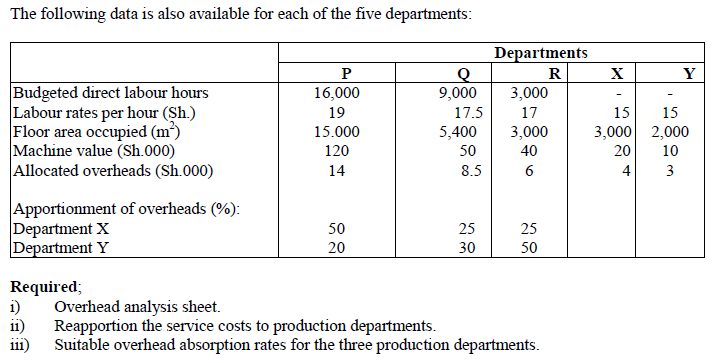
Date posted:
February 15, 2019
.
Answers (1)
-
Explain the reasons why an organisation might use overheads allocation and apportionment in
allocating costs among cost centres.
(Solved)
Explain the reasons why an organisation might use overheads allocation and apportionment in
allocating costs among cost centres.
Date posted:
February 15, 2019
.
Answers (1)
-
Explain the meaning of the following terms in the context of cost accounting:
i) Overtime premium.
(Solved)
Explain the meaning of the following terms in the context of cost accounting:
i) Overtime premium.
Date posted:
February 15, 2019
.
Answers (1)
-
Gemini Ltd. Manufactures a product branded "Bora” that uses two inputs of raw materials; Exe
and Wye. As a newly appointed cost accountant of Gemini Ltd.,...
(Solved)
Gemini Ltd. Manufactures a product branded "Bora” that uses two inputs of raw materials; Exe
and Wye. As a newly appointed cost accountant of Gemini Ltd., you have obtained the following
information:
1. Annual demand for the finished product is 64,000 units.
2. Each unit of "Bora" requires 3 kgs and I kg of material Exe and Wye respectively.
3. The production loss for material Exe is 5% of input.
4. It is not planned to change the stockholding of the finished product for the financial period
ahead, reduction of 6,000 kgs in the stock of material Exe is planned.
5. The ordering and holding costs are as follows:

6. A safety stock of 580 kgs of material Wye is held.
7. On average lead time is 2 weeks.
Assume 50 weeks in a year
Required;-
(i) Quantity of material Exe to be purchased.
(ii) Economic order quantity for materials Wye.
(iii) Re-order level for material Wye.
(iv) Annual ordering cost of material Wye.
(v) Annual holding cost of material Wye.
Date posted:
February 15, 2019
.
Answers (1)
-
Lengo Ltd. manufactures three products: A. B and C. There has been a proposal to change the
current convectional product costing system to an activity based...
(Solved)
Lengo Ltd. manufactures three products: A. B and C. There has been a proposal to change the current convectional product costing system to an activity based costing (ABC) system.
The following information relates to the month of September 2012.
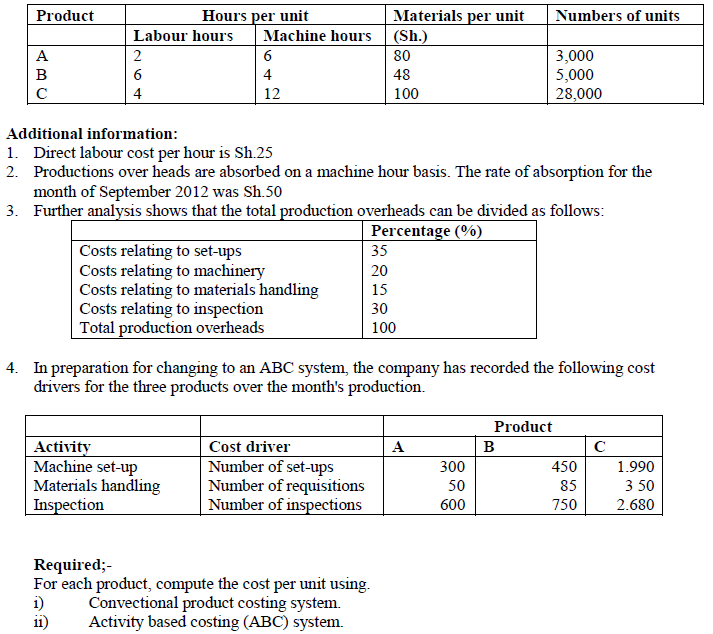
Date posted:
February 15, 2019
.
Answers (1)
-
Amdany Ltd. uses a part branded "Maxi" whose demand tends to be constant at an annual rate of 4.4
million units. The cost per unit for...
(Solved)
Amdany Ltd. uses a part branded 'Maxi' whose demand tends to be constant at an annual rate of 4.4
million units. The cost per unit for this part is Sh.220 and the cost of placing an order is Sh.550.
Amdany Ltd. estimates that the annual inventory carrying cost of the part expressed as a percentage of
cost of average inventory is 20%.
Required:
i) Compute the economic order quantity (EOQ).
ii) Compute the annual number of orders.
iii) Calculate the reorder point. Assume that lead time is 11 days and the company works for 330
days in a year.
Date posted:
February 15, 2019
.
Answers (1)
-
Copytech Ltd. sells and services photocopying machines. The company's sales department sells
the photocopying machines and consumables while the service department provides an after sale
service to...
(Solved)
Copytech Ltd. sells and services photocopying machines. The company's sales department sells
the photocopying machines and consumables while the service department provides an after sale
service to customers.
Currently, Copytech Ltd. uses a single overhead absorption rate to charge overheads based on total
sales revenue from copy charges. However, the service manager has proposed to change to activity
based costing (ABC) system and the following information has been obtained

Date posted:
February 15, 2019
.
Answers (1)
-
Distinguish between 'cost allocation' and 'cost absorption
(Solved)
Distinguish between 'cost allocation and 'cost absorption
Date posted:
February 15, 2019
.
Answers (1)
-
Jumbo Ltd. operates an incentive scheme where bonus hours are credited to the employees at the
rate of 20% of the time saved. During the first...
(Solved)
Jumbo Ltd. operates an incentive scheme where bonus hours are credited to the employees at the
rate of 20% of the time saved. During the first week of the month of May 2014, the following data
was recorded in relation to Mary Masumbi, a casual employee of Jambo Ltd.:

Additional information:
1. Bonus computations are based on accepted output.
2. The normal working hours in a week are 45 hours.
3. Overtime is paid at one and a half times the normal hourly rate.
4. The basic rate of pay is Sh.50 per hour.
Required:
Showing clearly the amounts earned for bonus and overtime, compute the total pay for Mary
Masumbi.
Date posted:
February 15, 2019
.
Answers (1)
-
Sneb Ltd. manufactures a single product branded 'BXL'. One of the components required to
manufacture product 'BXL' is 'RD'.
(Solved)
Sneb Ltd. manufactures a single product branded 'BXL'. One of the components required to
manufacture product 'BXL' is 'RD'.

Date posted:
February 15, 2019
.
Answers (1)
-
Lenga Juu Ltd. has three production departments and two service departments. The following are
the total production overhead costs which have been charged to the departments:
(Solved)
Lenga Juu Ltd. has three production departments and two service departments. The following are
the total production overhead costs which have been charged to the departments:
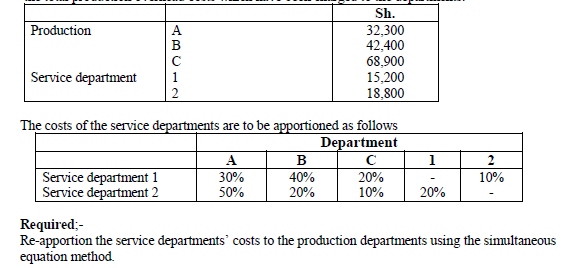
Date posted:
February 15, 2019
.
Answers (1)
-
Kenya Auto Assemblers Ltd assembles cars from imported knocked-down-kits. The company
has been operating at 60% capacity, assembling 3,000 cars per year.
The following information relates to...
(Solved)
Kenya Auto Assemblers Ltd assembles cars from imported knocked-down-kits. The company
has been operating at 60% capacity, assembling 3,000 cars per year.
The following information relates to the company‟s operations at two different levels of capacity.
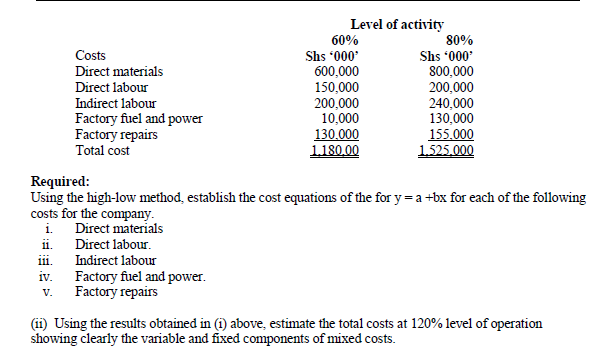
Date posted:
February 15, 2019
.
Answers (1)
-
In practice there is no cost that can be described as, entirely and always variable or fixed.'
Comment on the above statement.
(Solved)
In practice there is no cost that can be described as, entirely and always variable or fixed.'
Comment on the above statement.
Date posted:
February 15, 2019
.
Answers (1)
-
The information given below relates to Wasp Ltd. which manufactures a single type of
chemical. Overhead processing costs for the last thirteen accounting months (of four...
(Solved)
The information given below relates to Wasp Ltd. which manufactures a single type of
chemical. Overhead processing costs for the last thirteen accounting months (of four weeks
each) have been as follows:
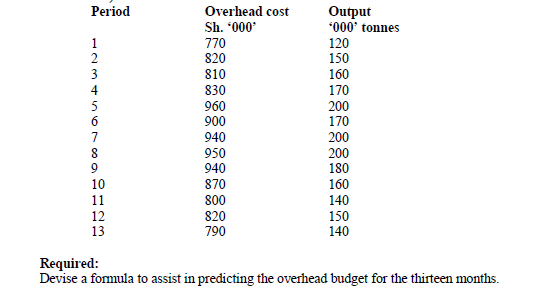
Date posted:
February 15, 2019
.
Answers (1)
-
Central Machinery Ltd ,Is preparing its budget for the year ending 30 June 2004.For the fuel
expenses consumption it is decided to estimate an equation of...
(Solved)
Central Machinery Ltd ,Is preparing its budget for the year ending 30 June 2004.For the fuel expenses consumption it is decided to estimate an equation of the form ,y=a + b x, where y is the total expense at an activity level x, a is the fixed expense and b is the rate of variable cost.

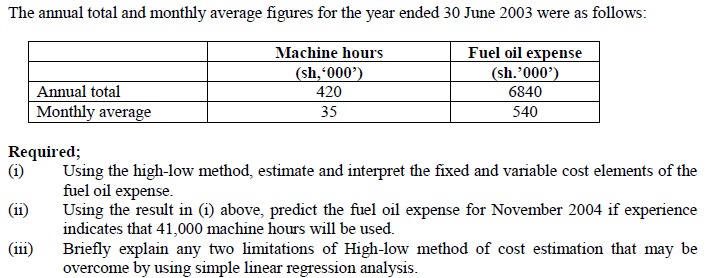
Date posted:
February 15, 2019
.
Answers (1)
-
Explain the advantage and disadvantages of high-low method of cost estimation.
(Solved)
Explain the advantage and disadvantages of high-low method of cost estimation.
Date posted:
February 15, 2019
.
Answers (1)
-
The management of Limuru processing Company Ltd. Wishes to obtain better cost estimates to
evaluate the company's operations more effectively
(Solved)
The management of Limuru processing Company Ltd. Wishes to obtain better cost estimates to
evaluate the company's operations more effectively

Date posted:
February 15, 2019
.
Answers (1)
-
State three disadvantages of using the high – low method for estimating costs
(Solved)
State three disadvantages of using the high – low method for estimating costs
Date posted:
February 15, 2019
.
Answers (1)